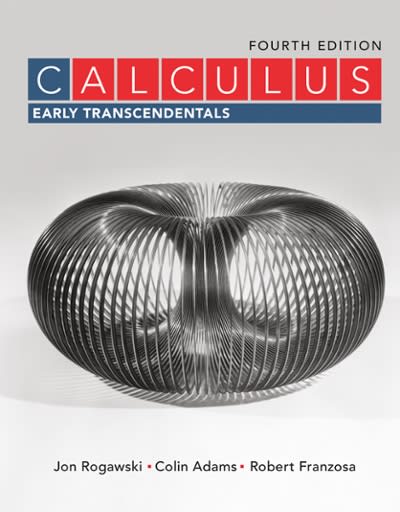Question
Please HELP 1. A scientist has developed a theoretical model for predicting eye color. After examining a random sample of parents, he predicts the eye
Please HELP
1. A scientist has developed a theoretical model for predicting eye color. After examining a random sample of parents, he predicts the eye color of the first child. The table found below lists the eye colors of offspring. On the basis of his theory, he predicted that 87% of the offspring will have brown eyes, 8% will have blue eyes, and 5% will have green eyes.
a) Calculate the expected frequencies. (use a 0.05 significance level to test the claim that the actual frequencies correspond to her predicted distribution, without using chisq.test function in R)
State the following:
- hypothesis
- test-statistic (the distribution and the corresponding degree of freedom)
- p-value
- conclusion of the problem
| Brown eyes | Blue eyes | Green eyes | |
| Observed Frequency | 132 | 17 | 0 |
| Expected Frequency |
b) Use chisq.test function in R to test the claim that the actual frequencies correspond to his predicted distribution, at a 0.05 significance level (please include a SCREENSHOT of the R output for this test)
2. Captopril, which is a drug that is designed to lower systolic blood pressure. When subjects were treated with this drug, their systolic blood pressure readings (in mm Hg) were measured before and after the drug was taken. Results are given in the accompanying table. Using a 0.01 significance level, determine if is there sufficient evidence to support the claim that captopril has an effect on systolic blood pressure?
a) Using the Wilcoxon signed-ranks test to conduct the required test without using "wilcox.test" function in R. State the hypothesis, the p-value, and the conclusion in the context of the problem
b) Using the Wilcoxon signed-ranks test to conduct the required test using "wilcox.test" function in R.
PLEASE PROVID A SCREENSHOT OF THE R OUTPUT OF THE CALL TO THE FUNCTION wilcox.test.
c) Will you recommend using the Wilcoxon signed-ranks test over the Sign-test? Explain.
| Subject | A | B | C | D | E | F | G | H | I | J | K | L |
| Before | 200 | 174 | 198 | 170 | 179 | 182 | 193 | 209 | 185 | 155 | 169 | 210 |
| After | 191 | 170 | 177 | 167 | 159 | 151 | 176 | 183 | 159 | 145 | 146 | 177 |
| Difference | -9 | -4 | -21 | -3 | -20 | -31 | -17 | -26 | -26 | -10 | -23 | -33 |
| Sign | - | - | - | - | - | - | - | - | - | - | - | - |
| Rank | 3 | 2 | 7 | 1 | 6 | 11 | 5 | 9.5 | 9.5 | 4 | 8 | 12 |
| Signed Rank | -3 | -2 | -7 | -1 | -6 | -11 | -5 | -9.5 | -9.5 | -4 | -8 | -12 |
Step by Step Solution
There are 3 Steps involved in it
Step: 1

Get Instant Access to Expert-Tailored Solutions
See step-by-step solutions with expert insights and AI powered tools for academic success
Step: 2

Step: 3

Ace Your Homework with AI
Get the answers you need in no time with our AI-driven, step-by-step assistance
Get Started


